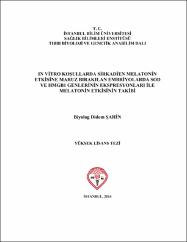| dc.contributor.advisor | Baltacı, Volkan | en_US |
| dc.contributor.author | Şahin, Didem | |
| dc.date.accessioned | 2015-02-09T08:19:40Z | |
| dc.date.available | 2015-02-09T08:19:40Z | |
| dc.date.issued | 2014 | |
| dc.date.submitted | 2014 | |
| dc.identifier.citation | Şahin, Didem. (2014). In Vitro Koşullarda Sirkadien Melatonin Etkisine Maruz Bırakılan Embriyolarda SOD ve HMGB1 Genlerinin Ekspresyonları ile Melatonin Etkisinin Takibi. Yayımlanmamış yüksek lisans tezi. İstanbul : İstanbul Bilim Üniversitesi, Sağlık Bilimleri Enstitüsü. | en_US |
| dc.identifier.uri | https://hdl.handle.net/11446/685 | en_US |
| dc.description | İstanbul Bilim Üniversitesi, Sağlık Bilimleri Enstitüsü, Tıbbi Biyoloji ve Genetik Ana Bilim Dalı Yüksek Lisans Programı | en_US |
| dc.description.abstract | Melatonin vücutta hemen hemen her organ sisteminde etkisi bulunan önemli bir mediyatördür. Bu mediatörler vücutta birçok hormonun regülasyonunu ve organizmanın sirkadien ritmini düzenler.
Amfofilik yapısı ve küçük moleküllü olması nedeniyle suda ve lipidlerde yüksek oranda çözünerek dolaşıma salıverildiğinde dokulara ve hücrelere kolaylıkla girebilmekte ve organizmada yaygın dağılım göstermektedir.
Melatonin uykuyu düzenleme, kanser gelişimi ve ilerlemesini önleme, yaşlanmayı geciktirme gibi fonksiyonları bulunan güçlü antioksidan, hücre yenileyici ve bağışıklık sistemi düzenleyicisidir. Bunun yanı sıra üreme ve fertilite üzerinde önemli etkileri vardır.
Süperoksit dismutaz (SOD) insanda mitokondri, sitoplazma ve ekstrasellüler ortamda bulunan antioksidan savunmasında çok önemli olup genleri 21. ve 6. kromozomların uzun kolunda, 4. kromozomun kısa kolunda lokalizedir. (21q22.1, 6q25.3 ve 4p15.3-p15.1).
HMGB1 (Yüksek Değişkenli Grup Proteinleri B1) insanda anti apoptotik etkisi bulunan önemli bir gendir.
Çalışmamızda kadın üreme hücreleri (oositler) ve erken embriyoların üzerinde melatonin reseptörlerinin gösterilmesi, bu reseptörlere bağlanan melatoninlerin SOD ve HMGB1 genlerinin expresyonları üzerinden fertilizasyon, embriyo gelişimi ve gebelik başarısı üzerine etkilerinin olup olmadığının araştırılması amaçlanmıştır. Bu amaçla infertilite problemi nedeniyle tüp bebek gerektiren hastalardan oluşturulan çalışma grubunda embriyo kültür medyumlarına melatonin eklenmiştir. Yine infertilite nedeniyle tüp bebek yapılan benzer özellikteki kontrol grubu hastalarının embriyoları ise melatonin içermeyen klasik kültür medyumlarında takip edilerek karşılaştırılmıştır. Her iki grup için vakaların artan embriyoları çalışmaya dahil edilmiştir. Bu embriyolardan alınan blastomer hücre yüzeylerinde Alexa Flour 488 ile işaretli Mel 1B (Melatonin 1B) reseptör antikoru kullanılarak immünofloresan işaretleme yapılmış melatonin reseptör varlığı teyid edilmiştir. Ayrıca yine fazla sayıda embriyo veya değişik gelişim aşamalarında olan yumurta hücrelerinden [M1 (Metafaz 1), M2 (Metafaz 2) veya GV (Germinal vezikül) oositler] Melatonin reseptörü (MT1) ekspresyonu gösterilmiştir. Yine bu hücrelerde SOD ve HMGB1 genlerinin ekspresyonları takip edilmiştir.
Çalışma grubu ve kontrol grubu arasındaki fertilizasyon, embriyo gelişimi ve blastokist aşamasına ulaşma oranları karşılaştırılmıştır. Sonuçlar dikkate alındığında istatiksel olarak anlamlı farklılıklar saptanmamıştır. | en_US |
| dc.description.abstract | Melatonin is a key factor which have crucial roles in nearly every system of the body. This factor organize, regulation of many hormones and circadian rhythm of the organism.
Due to its small size and amphaphilic structure melatonin is highly soluble in both water and lipids which allows it to penetrate into cells and tissues once it is released to circulation. This property of melatonin leads to its presence in many tissues of the organism.
Melatonin is a strong antioxidant which have key functions in regulation of sleep and immüne system, induction of cell renewal, inhibition of cancer progress, delay of aging. In addition to these functions melatonin also has key roles in fertilization.
Superoxide dismutase ( SOD) whose genes are localized on q arms of chromosomes 6, 21 and p arm of chromosome 4 (21q22.1, 6q25.3 ve 4p15.3-p15.1) encodes an enzyme which is found in cytoplasm, mitochondria and extracellular matrix of the cells and have important antioxidative effects.
Highly Multivariate Group Proteins b1 (HMGB1) is an important gene with antiapoptotic effects at cellular level.
The main objective of this study is to demonstrate the presence of melatonin receptors on woman germ cells (oocytes) and early embriyo stages and to further investigate the effects of melatonin on fertilization rates, embriyo development and gestation success via regulation of SOD1 and HMGB1 gene expression .
We have compared the study group consisting of IVF patients whose embriyos were cultured in mediums supplemented with melatonin, with control group consisting of IVF patients whose embriyos were cultured in mediums without melatonin to investigate the mentioned effects of melatonin.
We have demonstrated the presence melatonin receptor ( MT1) using a confocal microscope after performing immüneflouresctent labelling of the receptor with Alexa Flour 488 conjugated anticores .
We have also demonstrated the gene expression of MT1 using surplus oocytes at different developmental stages (M1, M2, GV oocytes) . In addition we have investigated expression of SOD and HMGB1 genes.
Evaluation of the results show that there is no statististically significant differences between the study group and the control group in terms of fertilization rates, embriyo development and rate of oocytes reaching blastocyts stage. | en_US |
| dc.language.iso | tur | en_US |
| dc.publisher | İstanbul Bilim Üniversitesi, Sağlık Bilimleri Enstitüsü. | en_US |
| dc.rights | info:eu-repo/semantics/openAccess | en_US |
| dc.title | In vitro koşullarda sirkadien melatonin etkisine maruz bırakılan embriyolarda SOD ve HMGB1 genlerinin ekspresyonları ile melatonin etkisinin takibi | en_US |
| dc.title.alternative | In vitro effects of melatonin circadian SOD and in embryos exposed to the effect of melatonin on the expression of genesis of HMGB1 Tracking | en_US |
| dc.type | masterThesis | en_US |
| dc.department | DBÜ, Sağlık Bilimleri Enstitüsü, Tıbbi Biyoloji ve Genetik Ana Bilim Dalı | en_US |
| dc.contributor.authorID | TR57435 | en_US |
| dc.relation.publicationcategory | Tez | en_US |
| dc.identifier.yoktezid | 455002 | en_US |


















